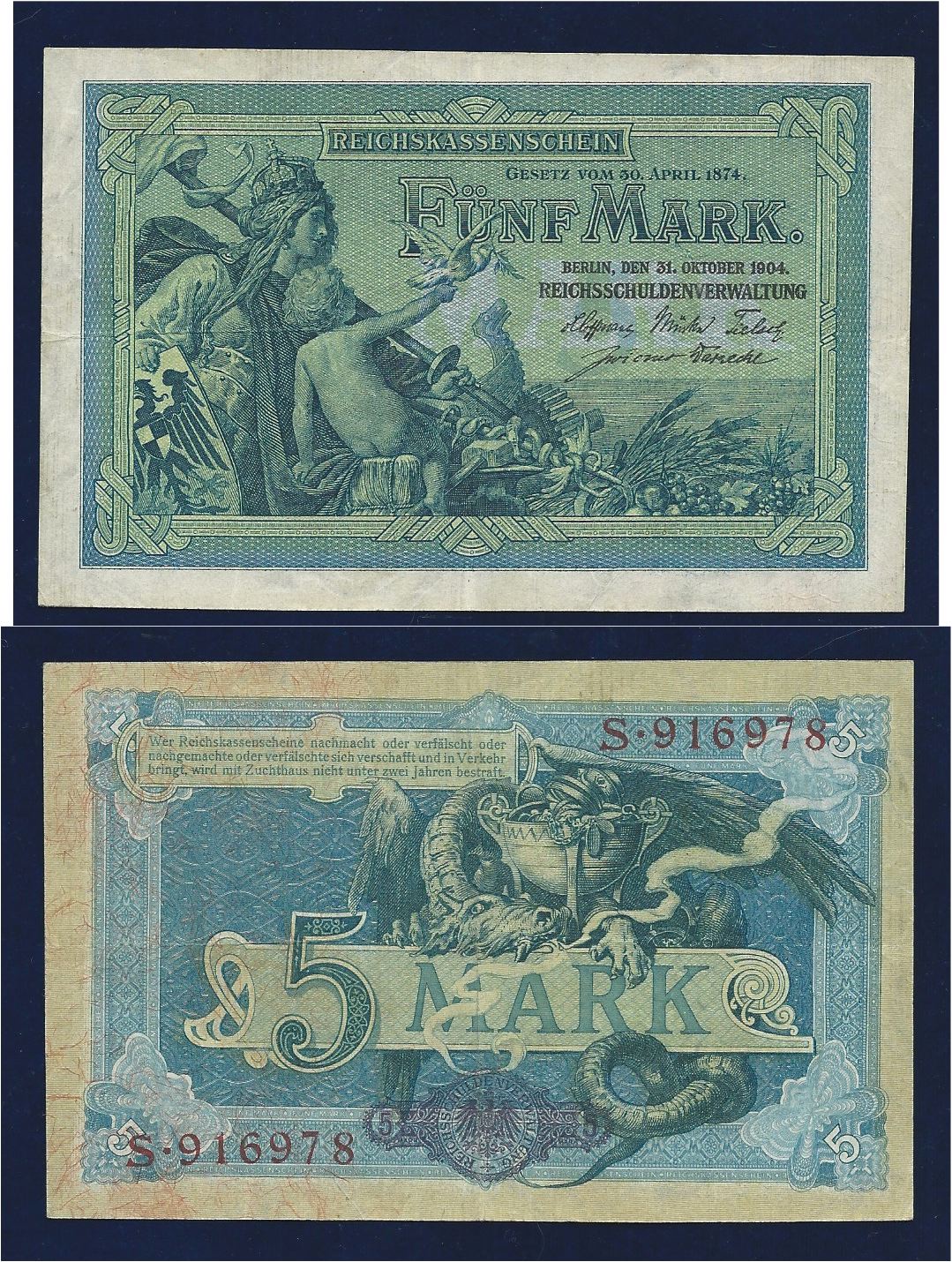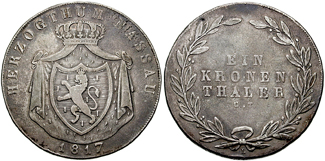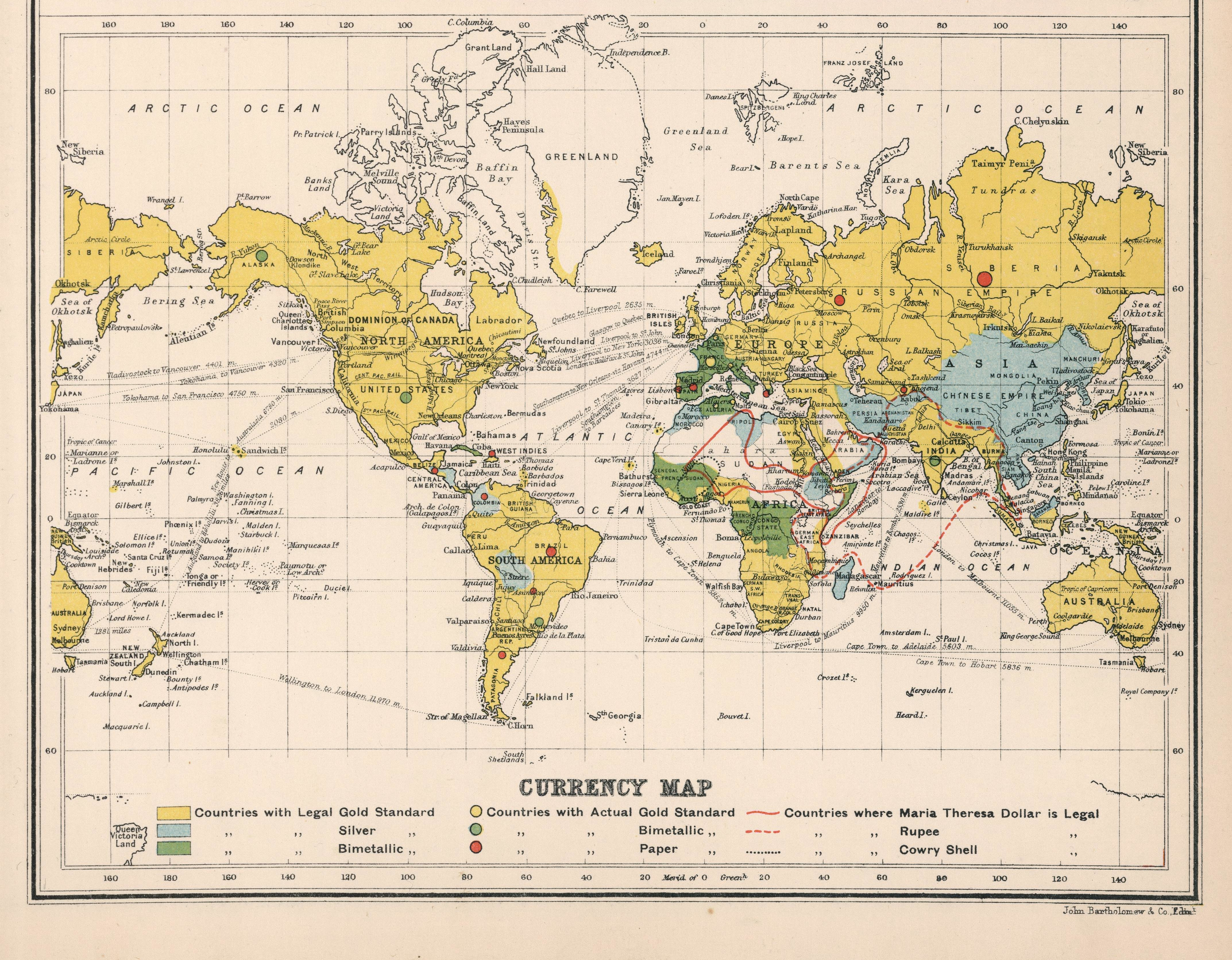|
в„і
The German mark ( ; sign: в„і︁) was the currency of the German Empire, which spanned from 1871 to 1918. The mark was paired with the minor unit of the pfennig (в‚°); 100 pfennigs were equivalent to 1 mark. The mark was on the gold standard from 1871 to 1914, but like most nations during World War I, the German Empire removed the gold backing in August 1914, and gold coins ceased to circulate. After the fall of the Empire due to the November Revolution of 1918, the mark was succeeded by the Weimar Republic's mark, derisively referred to as the Papiermark () due to hyperinflation in the Weimar Republic from 1918 to 1923. History The introduction of the German mark in 1873 was the culmination of decades-long efforts to unify the various currencies used by the German Confederation. The Zollverein unified in 1838 the Prussian and South German currencies at a fixed rate of 1 Prussian thaler = South German gulden = 16.704 g fine silver. A larger currency convention in 1857 r ... [...More Info...] [...Related Items...] OR: [Wikipedia] [Google] [Baidu] |
German Papiermark
The Papiermark (; 'paper mark') was a derisive term for the Mark (sign: в„іпёЃ) after it went off the gold standard, and most specifically with the era of hyperinflation in Germany of 1922 and 1923. Formally, the same German mark was used from 1871 to 1923. Like many countries, Germany departed the gold standard due to the outbreak of World War I, and stopped issuing gold coins backed in marks in August 1914. Precious metals rapidly disappeared from circulation, and inflation occurred as paper money was used to cover war debts in 1914 to 1918. Still, the papiermark is more associated with the early Weimar Republic era, when inflation grew out of control. By the time the mark was retired from circulation and renominated in December 1923, banknotes had amounts in the billions and trillions of marks by face value. History From 1914, the value of the mark fell. The rate of inflation rose following the end of World War I and reached its highest point in October 1923. The curre ... [...More Info...] [...Related Items...] OR: [Wikipedia] [Google] [Baidu] |
Bremen Thaler
The Thaler was the currency of the Free Hanseatic City of Bremen until 1873, when Germany adopted the gold mark (в„і). It was divided into 72 ''Grote'', each of 5 ''Schwaren''. While initially identical to the North German thaler before the 1750s, it was the only currency to maintain the gold standard of 5 thalers to a Friedrich d'or pistole from the 1750s until 1873, long after all other states adopted the '' Conventionsthaler''. North German Thaler Gold After implementation of the 1690 Leipzig currency standard the majority of the North German states defined the Reichsthaler currency as th a Cologne Mark of fine silver or 19.488 g. The gold-silver price ratio dropped, however, in the mid-18th century (down to 14.5 in France after 1726), leading many states to reissue their Reichsthaler currencies in cheaper Thaler Gold. By the 1730s the gold florin of 2.5036 g was valued at 2 thaler; hence each Thaler Gold was worth 1.2518 g gold or 18.15 g silver at France's gold ratio of ... [...More Info...] [...Related Items...] OR: [Wikipedia] [Google] [Baidu] |
Weimar Republic
The Weimar Republic, officially known as the German Reich, was the German Reich, German state from 1918 to 1933, during which it was a constitutional republic for the first time in history; hence it is also referred to, and unofficially proclaimed itself, as the German Republic. The period's informal name is derived from the city of Weimar, which hosted the constituent assembly that established its government. In English, the republic was usually simply called "Germany", with "Weimar Republic" (a term introduced by Adolf Hitler in 1929) not commonly used until the 1930s. The Weimar Republic had a semi-presidential system. Toward the end of the First World War (1914–1918), Germany was exhausted and suing for peace, sued for peace in desperate circumstances. Awareness of imminent defeat sparked a German Revolution of 1918–1919, revolution, Abdication of Wilhelm II, the abdication of Kaiser Wilhelm II, the proclamation of the Weimar Republic on 9 November 1918, and formal cessa ... [...More Info...] [...Related Items...] OR: [Wikipedia] [Google] [Baidu] |
Currency Sign
A currency symbol or currency sign is a graphic symbol used to denote a currency unit. Usually it is defined by a monetary authority, such as the national central bank for the currency concerned. A symbol may be positioned in various ways, according to national convention: before, between or after the numeric amounts: , and . Symbols are neither defined nor listed by international standard ISO 4217, which only assigns three-letter codes. Usage When writing currency amounts, the location of the symbol varies by language. For currencies in English-speaking countries and in most of Latin America, the symbol is placed before the amount, as in . In most other countries, including many in Europe and Canada (when using French), the symbol is placed after the amount, as in . Exceptionally, the symbol for the Cape Verdean escudo (like the Portuguese escudo, to which it was formerly currency peg, pegged) is placed in the decimal separator position, as in . [BCV's most recent coin issue ... [...More Info...] [...Related Items...] OR: [Wikipedia] [Google] [Baidu] |
South German Gulden
The South German Gulden was the currency of the states of Southern 18th century history of Germany, Germany between 1754 and 1873. These states included Bavaria, Baden, WГјrttemberg, Free City of Frankfurt, Frankfurt and Hohenzollern. It was divided into 60 kreuzer, with each kreuzer worth 4 pfennig or 8 Heller (coin), heller. History This specific ''Gulden'' was based on the ''Guilder, Gulden'' or ''Florin (Italian coin), florin'' used in the Holy Roman Empire during the Late Middle Ages and Early Modern period. The ''Gulden'' first emerged as a common currency of the Holy Roman Empire after the 1524 ''ReichsmГјnzordnung'' in the form of the ''Guldengroschen''.Shaw (1896), p. 364: Imperial Mint Ordinance of 1524 defines a silver piece = 1 Rhenish gold gulden. On p 363: the silver equivalent of the guld gulden... received the name gulden groschen. In the succeeding centuries the ''Gulden'' was then defined as a fraction of the ''Reichsthaler'' specie or silver coin. As of 16 ... [...More Info...] [...Related Items...] OR: [Wikipedia] [Google] [Baidu] |
German Unification
The unification of Germany (, ) was a process of building the first nation-state for Germans with federal features based on the concept of Lesser Germany (one without Habsburgs' multi-ethnic Austria or its German-speaking part). It commenced on 18 August 1866 with the adoption of the North German Confederation Treaty establishing the North German Confederation, initially a military alliance ''de facto'' dominated by the Kingdom of Prussia which was subsequently deepened through adoption of the North German Constitution. The process symbolically concluded when most of the south German states joined the North German Confederation with the ceremonial proclamation of the German Empire (German Reich) having 25 member states and led by the Kingdom of Prussia of Hohenzollerns on 18 January 1871; the event was typically celebrated as the date of the German Empire's foundation, although the legally meaningful events relevant to the completion of unification occurred on 1 January 18 ... [...More Info...] [...Related Items...] OR: [Wikipedia] [Google] [Baidu] |
French Franc
The franc (; , ; currency sign, sign: F or Fr), also commonly distinguished as the (FF), was a currency of France. Between 1360 and 1641, it was the name of coins worth 1 livre tournois and it remained in common parlance as a term for this amount of money. It was reintroduced (in French livre, decimal form) in 1795. After two centuries of inflation, it was Redenomination, redenominated in 1960, with each (NF) being worth 100 old francs. The NF designation was continued for a few years before the currency returned to being simply the franc. Many French residents, though, continued to quote prices of especially expensive items in terms of the old franc (equivalent to the new centime), up to and even after the introduction of the euro (for coins and banknotes) in 2002. The French franc was a commonly held international reserve currency of reference in the 19th and 20th centuries. Between 1998 and 2002, the conversion of francs to euros was carried out at a rate of 6.55957 franc ... [...More Info...] [...Related Items...] OR: [Wikipedia] [Google] [Baidu] |
Treaty Of Frankfurt (1871)
The Treaty of Frankfurt (; ) was a peace treaty signed in Frankfurt on 10 May 1871, at the end of the Franco-Prussian War. Summary The treaty did the following: * Established the frontier between the French Third Republic and the German Empire, which involved the ceding of 1,694 French villages and cities to Germany in: ** Alsace: the French departments of Bas-Rhin and Haut-Rhin, except for the city of Belfort and its territory; ** Lorraine: most of the French department of Moselle, one-third of the department of Meurthe, including the cities of ChГўteau-Salins and Sarrebourg, and the cantons Saales and Schirmeck in the department of Vosges. * Gave residents of the Alsace-Lorraine region until 1 October 1872 to decide between keeping their French nationality and emigrating, or remaining in the region and becoming German citizens. * Set a framework for the withdrawal of German troops from certain areas. * Regulated the payment of France's war indemnity of five billion ... [...More Info...] [...Related Items...] OR: [Wikipedia] [Google] [Baidu] |
Latin Monetary Union
The Monetary Convention of 23 December 1865 was a unified system of coinage that provided a degree of monetary integration among several European countries, initially Belgium, France, Italy and Switzerland, at a time when the circulation of banknotes in these countries remained relatively marginal. In early 1866, it started being referred to in the British press as the Latin Monetary Union, with intent to make clear that the United Kingdom would not join, and has been generally referred to under that name () and the acronym LMU since then. A number of countries minted coins according to the LMU standard even though they did not formally join the LMU. The LMU has been viewed as a forerunner of late-20th-century European monetary union but cannot be directly compared with it, not least since the LMU did not rely on any common institutions. Unlike the Scandinavian Monetary Union established a few years later, the Latin Monetary Union remained limited to coinage and never extended ... [...More Info...] [...Related Items...] OR: [Wikipedia] [Google] [Baidu] |
Silver Standard
The silver standard is a monetary system in which the standard economic unit of account is a fixed weight of silver. Silver was far more widespread than gold as the monetary standard worldwide, from the Sumerians 3000 BC until 1873. Following the discovery in the 16th century of large deposits of silver at the Cerro Rico in PotosГ, Bolivia, an international silver standard came into existence in conjunction with the Spanish pieces of eight. These silver dollar coins were an international trading currency for nearly four hundred years. The move away from the silver to the gold standard began in the 18th century when Great Britain set the gold guinea’s price in silver higher than international prices, on the recommendation of Sir Isaac Newton, thus attracting gold and putting Great Britain on a de facto gold standard. Great Britain formalised the gold standard in 1821 and introduced it to its colonies afterwards. Imperial Germany’s move to the gold standard in 1873 trigger ... [...More Info...] [...Related Items...] OR: [Wikipedia] [Google] [Baidu] |
Bimetallism
Bimetallism, also known as the bimetallic standard, is a monetary standard in which the value of the monetary unit is defined as equivalent to certain quantities of two metals, typically gold and silver, creating a fixed Exchange rate, rate of exchange between them. For scholarly purposes, "proper" bimetallism is sometimes distinguished as permitting that both gold and silver money are legal tender in unlimited amounts and that gold and silver may be taken to be coined by the Mint (facility), government mints in unlimited quantities. This distinguishes it from "limping standard" bimetallism, where both gold and silver are legal tender but only one is freely coined (e.g. the monies of France, Germany, and the United States after 1873), and from "trade" bimetallism, where both metals are freely coined but only one is legal tender and the other is used as "trade money" (e.g. most monies in western Europe from the 13th to 18th centuries). Economists also distinguish ''legal'' bimeta ... [...More Info...] [...Related Items...] OR: [Wikipedia] [Google] [Baidu] |
North German Thaler
The North German thaler was a currency used by several states of Northern Germany from 1690 to 1873, first under the Holy Roman Empire, then by the German Confederation. Originally equal to the Reichsthaler specie or silver coin from 1566 until the ''Kipper und Wipper'' crisis of 1618, a ''thaler'' currency unit worth less than the ''Reichsthaler specie'' was first defined in 1667 and became widely used after adoption of the Leipzig currency standard of 1690. After the 1840s, the different North German states made their thalers equal in value to the ''Prussian thaler''; these thalers were then made par to the ''Vereinsthaler'' in 1857. The various North German ''thalers'' and ''vereinsthalers'' were all replaced in 1873 by the ''German gold mark'' at the rate of 3 marks per ''thaler''. Several old books confusingly use the same term Reichsthaler for the ''specie silver coin'' as well as the ''currency unit''. This is disambiguated by referring to the full-valued coin as the ''Rei ... [...More Info...] [...Related Items...] OR: [Wikipedia] [Google] [Baidu] |





